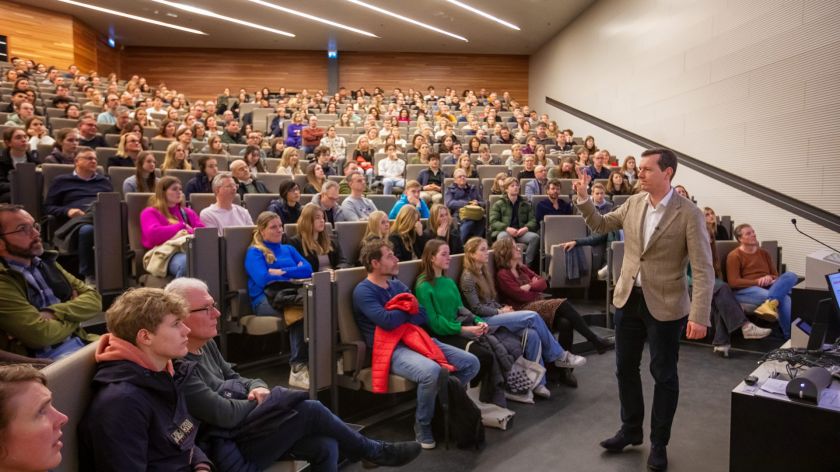Radboud has its very own crystal ball: a model to predict student intake numbers
-
 Toekomstige studenten (en enkele ouders) tijdens de bachelor open dag eerder dit jaar. Foto: Dick van Aalst
Toekomstige studenten (en enkele ouders) tijdens de bachelor open dag eerder dit jaar. Foto: Dick van Aalst
How many students will start a specific course next year? Or at the university as a whole? With the help of ‘machine learning’, the university has developed a prognosis model that gives a pretty accurate answer to that question.
It’s extremely helpful for course coordinators and teachers to know exactly how many new students they’ll be teaching next year. After all: how many teachers are needed exactly, and is a small or large lecture hall needed?
‘In the past, we would only have the definite student numbers once the students were in their seats at the start of the year’, according to Han Werts, head of the Department of Institutional Research at Radboud University. ‘Obviously, it’s much better if courses can better prepare themselves in advance.’
The information is also relevant to the various faculties, as well as the Executive Board; the University’s financing is partly decided by the number of students.
Predictions
That is why employees of Institutional Research developed a prognosis model; using it, anyone can look up how many students are expected to attend a specific programme, faculty, or the university in general next academic year. The model also gives other information, such as the total number of international students coming to Nijmegen.
The model is aimed at the upcoming year, and first-year students in particular; it shows the prospective intake numbers for the 2024-2025 academic year. Starting in September, the model will begin making predictions for the next academic year.
The various programmes’ future income predictions were not very reliable, as they were solely based on so-called pre-signup figures. Those did not paint a clear picture, as prospective students can sign up for various courses simultaneously -and often do- before making a final selection.
Machine Learning
However, this raises the question: How did the employees at the Institutional Research find out how to build a model that can make accurate predictions? ‘To do that, we had to dive into the intake numbers, all the way back to 2011’, according to data analyst Amir Khodaie. ‘That is a lot of old data. We fed it to a machine learning algorithm, which looked for connections between the number of pre-signups and actual signups.’
Khodaie explains that, to make predictions even more accurate, the system also calculates the individual odds of someone finalising a sign-up. ‘We do that with a range of data, such as the applicants’ addresses.’ Statistically, there is a greater chance that a student from Wijchen or Elst will end up coming to the University than a student from Rotterdam.
‘The model already made fairly accurate predictions in October’
The prognosis model works with the pre-registration numbers, which will start trickling in for the upcoming academic year from September onwards. Predictions become more accurate over time, as more people sign up. ‘The model already made fairly accurate predictions in October’, says Werts. ‘We tested it extensively, using historical data.’
Expansion
But even now that the prognosis model is online, the work of the developers is not yet finished. The employees at Institutional Research want to expand the model even further over the next couple of years. The first step: to predict not only new student intake, but also the overall student population – including previous academic years.
Not only that, but Werts and Khodaie have more ambitions. ‘There is a great need to predict further than just a single year’, says Werts. For that, the university is currently reliant on estimates by the government. However, those have proven to be inaccurate at times, which is a real problem. If actual signup numbers fail to match up to the predictions, the university also receives less funding than anticipated.
Furthermore, the estimates are about the institutions as a whole, and not about specific faculties or courses. Khodaie: We are now testing if we can do predictions of sign-up numbers for each programme for the next few years.’ That can also be done based on historical data, but Khodaie says it’s possible they may have to use external data sources, such as demographic databases from the CBS.
‘The further you want to look into the future, the greater the margin of error’, Werts explains. ‘but I am hopeful that shortly we can make predictions further into the future.’
More International Students
The prognosis model shows fewer first-year students (bachelor and master) next year when compared to the current academic year (7577 compared to 7817). This decline is most clear at the Faculty of Social Sciences. At the Faculty of Management faculty, burdened with deficit of millions of euros, the intake numbers for next year look stable.
Despite the heated debate regarding the internationalisation of higher education, an larger intake of international students is predicted in Nijmegen (1108 compared to 953 last year).



